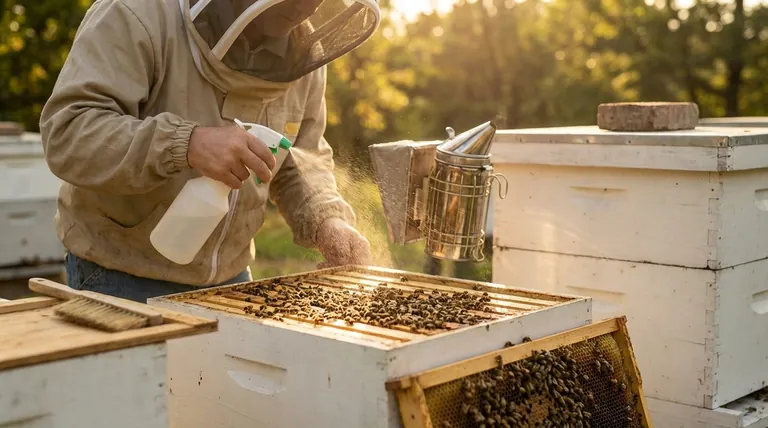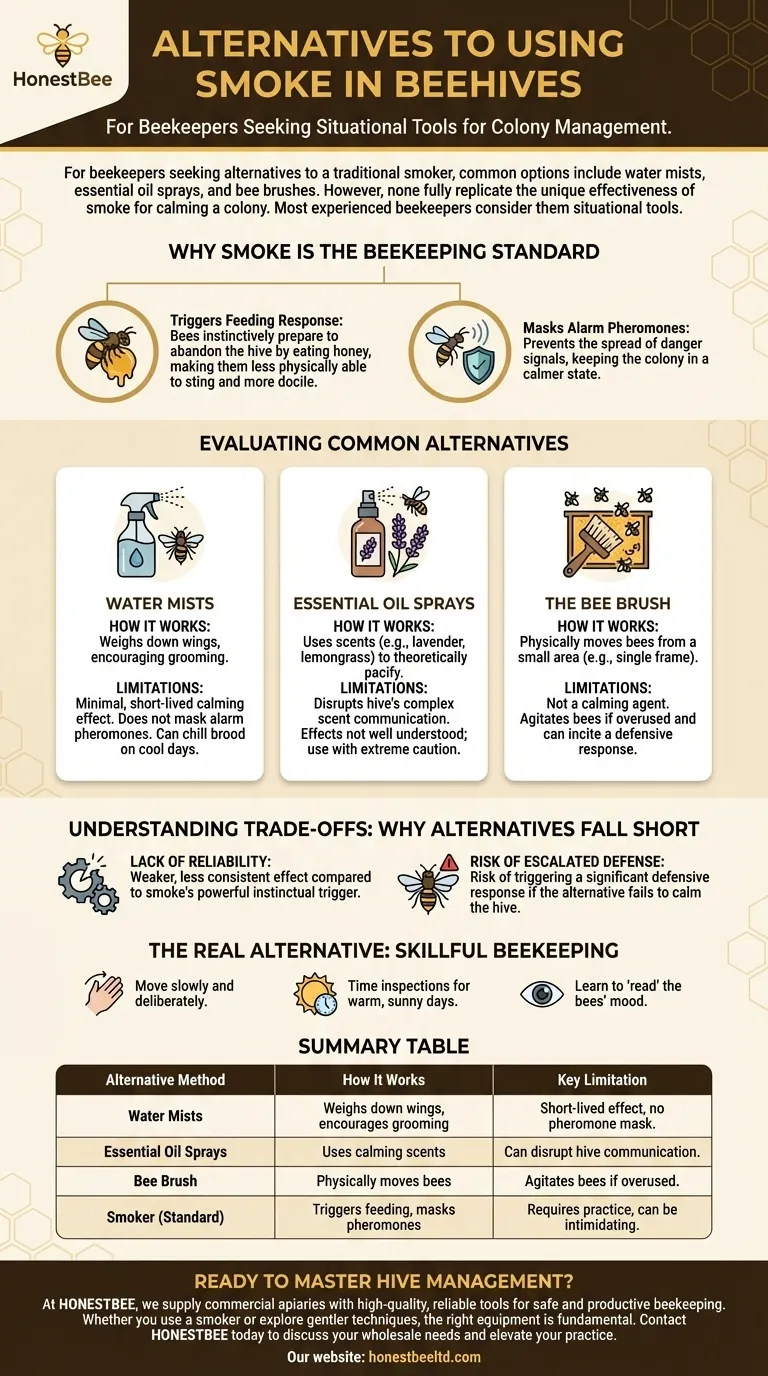For beekeepers seeking alternatives to a traditional smoker, the most common options include water mists (plain or with sugar), sprays containing essential oils, and physical tools like a bee brush. However, it's crucial to understand that while these methods exist, none fully replicate the unique effectiveness of smoke for calming a colony during a full inspection. Most experienced beekeepers consider them situational tools rather than direct replacements.
The search for a smoke alternative is often a search for a gentler, more convenient way to manage bees. While no single tool replaces a smoker, the true alternative is a holistic approach that combines gentle handling, proper timing, and a deep understanding of bee behavior.

Why Smoke is the Beekeeping Standard
To properly evaluate alternatives, we must first understand why smoke is so effective. Its impact is rooted in the bees' natural instincts.
Triggers a Feeding Response
When bees detect smoke, they instinctively believe a forest fire is near. Their immediate response is to prepare to abandon the hive by engorging themselves on honey. A bee with a full stomach is physically less able to bend its abdomen to sting and is generally more docile.
Masks Alarm Pheromones
When a bee stings or feels threatened, it releases alarm pheromones. These chemical signals alert other bees to a danger, escalating the hive's defensive response. Smoke effectively masks these pheromones, preventing a chain reaction and keeping the colony in a calmer state.
Evaluating the Common Alternatives
Each alternative has a different mechanism of action and comes with significant limitations compared to smoke.
Water Mists
Using a spray bottle to apply a fine mist of water (or sugar water) is a popular technique. It works by weighing down the bees' wings, making it harder for them to fly, and encouraging them to focus on cleaning themselves.
However, its calming effect is minimal and short-lived. It does not mask alarm pheromones, and on cool days, it can chill the brood and make the bees uncomfortably wet.
Essential Oil Sprays
Some beekeepers add essential oils like lavender or lemongrass to a water spray. The theory is that these calming scents can help pacify the bees.
Use these with extreme caution. The colony relies heavily on complex scent cues for communication, and the full effect of introducing powerful, foreign oils is not well understood. What may seem calming could be disrupting the hive's internal communication.
The Bee Brush
A bee brush is a tool for physically moving bees. It is effective for gently clearing a small number of bees off a single frame when you need a clear view or are preparing to harvest honey.
A brush should never be used as a primary calming agent. Brushing a large number of bees tends to agitate them and can easily incite a defensive response, making the situation worse.
Understanding the Trade-offs: Why Alternatives Fall Short
Choosing a less-effective tool is not without risk. An inadequately managed inspection can be more stressful for both the bees and the beekeeper.
The Lack of Reliability
Smoke's effectiveness is consistent and based on a powerful, instinctual reaction. Alternatives like water mists offer a much weaker, less reliable effect that can fail when you need it most, particularly if the colony is already defensive.
The Risk of an Escalated Defense
If an alternative fails to calm the hive and you proceed with an inspection, you risk triggering a significant defensive response. This leads to more stings for you and a higher number of dead bees, as honey bees die after stinging a mammal.
The Real Alternative: Skillful Beekeeping
Many experienced beekeepers find they use less smoke over time, not because they switched tools, but because their technique improved. The ultimate goal is to work with the bees in a way that minimizes their stress from the start. This includes:
- Moving slowly and deliberately inside the hive.
- Timing inspections for warm, sunny days when most foragers are out.
- Learning to "read" the bees' mood and knowing when it's best to close the hive and return another day.
Making the Right Choice for Your Goal
The right tool depends entirely on your specific task and the temperament of your colony.
- If your primary focus is a quick task on a known gentle hive: A light water mist might be all you need to move a few bees out of the way.
- If your primary focus is clearing a few bees from one frame: A bee brush is the correct tool for that specific job, but it is not a calming agent.
- If your primary focus is a full, safe inspection of the brood nest: A traditional smoker remains the most reliable and effective tool for ensuring the safety of both you and your bees.
Ultimately, effective hive management comes from skill and understanding, not just the tool in your hand.
Summary Table:
| Alternative Method | How It Works | Key Limitation |
|---|---|---|
| Water Mists | Weighs down wings, encourages grooming. | Short-lived effect, does not mask alarm pheromones. |
| Essential Oil Sprays | Uses calming scents to pacify bees. | Can disrupt hive communication; effects not well understood. |
| Bee Brush | Physically moves bees to clear an area. | Agitates bees if overused; not a calming agent. |
| Smoker (Standard) | Triggers feeding response & masks alarm pheromones. | Requires practice to use effectively; can be intimidating for beginners. |
Ready to Master Hive Management with the Right Tools?
At HONESTBEE, we supply commercial apiaries and beekeeping equipment distributors with the high-quality, reliable tools needed for safe and productive beekeeping. Whether you rely on a traditional smoker or are exploring gentler techniques, having the right equipment is fundamental to your success.
Let our experts help you build a toolkit that matches your beekeeping philosophy and operational scale. Contact HONESTBEE today to discuss your wholesale needs and elevate your beekeeping practice.
Visual Guide

Related Products
- European Stainless Steel Bee Smoker for Honey Bee Hive
- Economy Galvanized Beekeeping Honey Bee Smoker for Wholesale
- Professional Bee Smoker with Elongated Spout and Durable Bellows for Beekeeping
- Premium Traditional Copper Bee Smoker with Bellows
- Stainless Steel Honey Bee Smoker Hive and Honeycomb Smoker for Beekeeping
People Also Ask
- What factors should be considered when choosing a bee smoker? Find the Right Tool for Safe, Effective Hive Management
- What are the features of a recommended bee smoker? A Guide to Safety, Durability & Performance
- What are the advantages of a high-quality bee smoker? Achieve Calm, Confident Hive Management
- What are the steps to operate a bee smoker? Master the Art of Gentle Beehive Management
- What are the differences between stainless steel and galvanized steel bee smokers? Choose the Right Smoker for Your Apiary



















